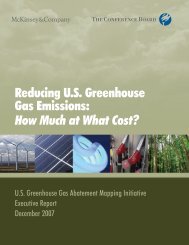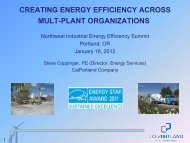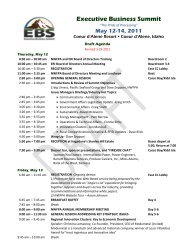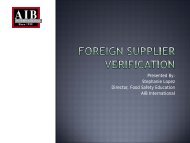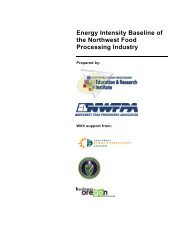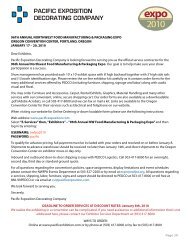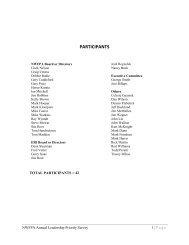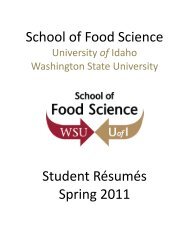A Guide for Food Processors - Northwest Food Processors Association
A Guide for Food Processors - Northwest Food Processors Association
A Guide for Food Processors - Northwest Food Processors Association
You also want an ePaper? Increase the reach of your titles
YUMPU automatically turns print PDFs into web optimized ePapers that Google loves.
A <strong>Guide</strong> <strong>for</strong> <strong>Food</strong> <strong>Processors</strong>
Published by:<br />
<strong>Northwest</strong> <strong>Food</strong> <strong>Processors</strong><br />
<strong>Association</strong> (NWFPA) and<br />
the <strong>Northwest</strong> <strong>Food</strong> <strong>Processors</strong><br />
Education & Research Institute (ERI)<br />
This publication was supported by<br />
the Oregon Business Development<br />
Department, Oregon Department<br />
of Agriculture, and the Idaho State<br />
Department of Agriculture.<br />
© 2012 <strong>Northwest</strong> <strong>Food</strong><br />
<strong>Processors</strong> <strong>Association</strong><br />
PREPARED BY:<br />
David McGiverin, Sustainability and<br />
Productivity Manager, NWFPA<br />
Pamela Barrow, Energy Director,<br />
NWFPA<br />
2 | NWFPA Sustainability <strong>Guide</strong><br />
Special Thanks to:<br />
THE NWFPA SUSTAINABILITY TASK FORCE<br />
ConAgra - Lamb Weston (Paul Halberstadt)<br />
Del Monte <strong>Food</strong>s (Robin Connell & John Wisse)<br />
National Frozen <strong>Food</strong>s (Amyris Borgo)<br />
Oregon Cherry Growers (Steve Kollars)<br />
J.R. Simplot (Alan Prouty)<br />
Tillamook County Creamery (Shawn Reiersgaard)<br />
Tree Top, Inc. (Chris Cary)<br />
Truitt Brothers (Heather McPherson)<br />
For additional<br />
in<strong>for</strong>mation, contact:<br />
sustainability@nwfpa.org<br />
503.327.2200<br />
www.nwfpa.org/sustainability
Table of<br />
Contents<br />
4Overview<br />
6Visioning<br />
Sustainability<br />
8Defi ning<br />
Environmental<br />
Sustainability<br />
12<br />
Defi ning<br />
Economic<br />
Sustainability<br />
16<br />
Defi ning Social<br />
Sustainability<br />
20<br />
Exercise in<br />
Determining<br />
Goals<br />
24<br />
Developing a<br />
Sustainability Plan<br />
26<br />
Communicating<br />
Progress<br />
3
Overview<br />
4 | NWFPA Sustainability <strong>Guide</strong><br />
The question <strong>for</strong> food<br />
processors today is not if, but<br />
how, they should manage their<br />
sustainability activities.
Although there are many defi nitions of sustainability,<br />
it has become the buzzword of the decade. Over<br />
time however, it has evolved from a mere buzzword<br />
to a business concept that is being embraced by<br />
more and more companies.<br />
5<br />
The question <strong>for</strong> food processors<br />
today is not if, but how, they should<br />
manage their sustainability activities.<br />
A robust sustainability program can<br />
be thought of as a three-legged<br />
stool with environmental (planet),<br />
economic (profi t) and social (people)<br />
issues each representing a<br />
leg of the stool. These three legs<br />
are often referred to as the “triple<br />
bottom line.” The environmental<br />
leg represents ef<strong>for</strong>ts to balance<br />
the use of limited resources today<br />
with the resource needs of tomorrow.<br />
Environmental sustainability<br />
addresses such topics as energy,<br />
water use, invasive species,<br />
genetically modifi ed seed, chemical<br />
fertilizers, soil erosion and the<br />
preservation of farmland.<br />
The economic sustainability leg of<br />
the stool focuses on issues which<br />
allow business to thrive in both the<br />
community and the marketplace.<br />
Economic sustainability initiatives<br />
return a profi t to shareholders or<br />
cooperative members, develop<br />
value-added products, establish<br />
market share, eliminate artifi cial<br />
barriers to business, and work to<br />
establish a level playing fi eld in the<br />
marketplace.<br />
The third leg, social responsibility,<br />
involves a company’s role in<br />
supporting a healthy and secure<br />
work<strong>for</strong>ce and investing in the community<br />
through taxes, leadership,<br />
social justice, and philanthropy.<br />
The intent of this Sustainability<br />
<strong>Guide</strong> <strong>for</strong> <strong>Food</strong> <strong>Processors</strong> is to<br />
aide in defi ning sustainability as it<br />
applies to food processing. But,<br />
more importantly, it seeks to move<br />
beyond defi nitions to assist food<br />
processors in developing individualized<br />
sustainability programs to meet<br />
the needs of their companies, their<br />
communities, and their consumers.
Visioning<br />
Sustainability<br />
6 | NWFPA Sustainability <strong>Guide</strong><br />
For more than a<br />
century, the food<br />
processing industry<br />
has been, and<br />
continues to be, an<br />
integral part of the<br />
<strong>Northwest</strong> economy.<br />
The continued viability<br />
of the industry is<br />
dependent upon<br />
the success of our<br />
ongoing ef<strong>for</strong>ts to<br />
address water, energy,<br />
safety, community<br />
and environmental<br />
responsibilities.<br />
–NORTHWEST FOOD PROCESSORS<br />
ASSOCIATION SUSTAINABILITY<br />
TASK FORCE, 2010<br />
In NWFPA’s vision, <strong>Northwest</strong> food<br />
processors are national leaders in<br />
the food processing industry. To<br />
achieve our vision, NWFPA’s leadership<br />
identifi ed sustainability as a key<br />
strategic priority <strong>for</strong> food processing<br />
and established an objective to<br />
“mainstream” sustainability in the<br />
industry. In 2012, NWFPA launched<br />
a major sustainability initiative and<br />
the NWFPA board elevated the<br />
Sustainability Task Force to standing<br />
committee status in the association.<br />
The new Sustainability Committee’s<br />
membership was broadened to<br />
include representatives of NWFPA’s<br />
fi ve other standing committees.<br />
This echoes the contemporary<br />
approach to sustainability as the<br />
umbrella under which many areas<br />
of ef<strong>for</strong>t fall, including energy, water,<br />
waste, greenhouse gas emissions,<br />
work<strong>for</strong>ce, and community involvement.<br />
Broader participation in the<br />
Sustainability Committee will assure<br />
development of products and services<br />
that will serve as resources <strong>for</strong><br />
NWFPA members in their sustainability<br />
ef<strong>for</strong>ts.<br />
This Sustainability <strong>Guide</strong> was<br />
developed as just such a resource<br />
to help food processors create<br />
their own sustainability programs.<br />
The <strong>Guide</strong> is divided into two sections:<br />
(1) identifying sustainability<br />
opportunities; and (2) developing<br />
a plan of action. The identifi cation<br />
section addresses the three legs<br />
of sustainability – planet, profi t and<br />
Broader participation in the Sustainability<br />
Committee will assure development of products<br />
and services that will serve as resources <strong>for</strong><br />
NWFPA members in their sustainability ef<strong>for</strong>ts.
Sustainability has become a business necessity in a<br />
world demanding transparency and accountability.<br />
7<br />
people. Each leg is discussed in a<br />
four-page spread that provides a<br />
brief defi nition, specifi c examples<br />
of NWFPA member activities,<br />
associated sustainable practices,<br />
key questions to ask yourself,<br />
and references to additional<br />
resources. The second section of<br />
the <strong>Guide</strong> focuses on coalescing<br />
your thoughts and resources into a<br />
viable sustainability action plan.<br />
Developing<br />
Your Vision<br />
Sustainability has become a<br />
business necessity in a world<br />
demanding transparency and<br />
accountability. Customers and<br />
consumers often associate businesses<br />
that implement sustainable<br />
practices with quality products and<br />
services. Further, some investors<br />
now look at sustainability per<strong>for</strong>mance<br />
as a predictor of overall<br />
business profi tability or indicator of<br />
overall business value.<br />
The fundamental concepts of<br />
sustainability are not new. Your<br />
company may already have many<br />
sustainable practices in place.<br />
This <strong>Guide</strong> is designed to suggest<br />
refi nements to current practices and<br />
to facilitate further thinking about<br />
new opportunities while enabling<br />
you to <strong>for</strong>mulate a sustainability plan<br />
with vision and purpose.<br />
Vision Statement<br />
Examples<br />
AJINOMOTO FROZEN FOODS<br />
USA, INC. As a truly global company,<br />
we are committed to social<br />
and environmental sustainability.<br />
We will contribute toward this goal<br />
through the fi elds of <strong>Food</strong> and<br />
Health like no other company can,<br />
and will strive to earn the trust of the<br />
people of the world <strong>for</strong> generations<br />
to come.<br />
DEL MONTE FOODS At Del Monte<br />
<strong>Food</strong>s, our vision is to nourish<br />
families and enrich lives, every day.<br />
We’re passionate about bringing<br />
high-quality, healthy, and nutritious<br />
foods to people and their pets in a<br />
way that protects the environment,<br />
builds strong ties to our communities,<br />
and enables our Company to<br />
grow and fl ouris<br />
HEINZ FROZEN FOOD COMPANY<br />
We defi ne a compelling, sustainable<br />
future and create the path to<br />
achieve it.
8 | NWFPA Sustainability <strong>Guide</strong><br />
Environmental<br />
Sustainability<br />
Definition: Availability of resources including<br />
water, land and energy to grow and process food<br />
products at sustainable rates, quality and cost<br />
through continuous improvement.
<strong>Food</strong> production practices can potentially have<br />
profound impacts on an ecosystem and its natural<br />
resources. The way we cultivate crops, redistribute<br />
water, and dispose of waste can be the difference<br />
between a thriving wetlands and a desolate<br />
landscape. Through our raw products, food processors<br />
are directly linked to the natural environment.<br />
Responsible stewardship of the environment is critical<br />
to a sustained food processing industry.<br />
9<br />
Land<br />
Land provides the substance<br />
from which our food sources<br />
derive sustenance and grow. It is<br />
the foundation of the food industry.<br />
Non-sustainable practices<br />
can lead to encroachment of<br />
invasive species, degradation of<br />
soil nutrients, and over-reliance<br />
on fertilizers and pesticides, often<br />
with unintended consequences.<br />
The long-term viability of the food<br />
processing industry is dependent<br />
on healthy land resources.<br />
Water<br />
Water represents the lifeblood<br />
of the environment, providing a<br />
constant stream of sustenance<br />
that can enhance, or limit, a<br />
region’s ability to survive. Water<br />
is a critical input to agriculture<br />
and food processing and many<br />
of the larger food processors<br />
use over a million gallons of<br />
water per day. But water supply<br />
and availability are becoming<br />
signifi cant concerns in parts of<br />
the <strong>Northwest</strong> as well as the<br />
nation. Industrial wastewater is<br />
also an important environmental<br />
concern. To assure that suffi<br />
cient clean water is available<br />
<strong>for</strong> our and future generations,<br />
water must be effi ciently used<br />
and wastewater properly treated<br />
and disposed.<br />
Waste & Emissions<br />
Waste is of particular concern<br />
as new food safety standards<br />
have demanded sanitary<br />
packaging and containers<br />
that can present a signifi cant<br />
burden to the environment when<br />
disposed. Today’s processed<br />
goods are often individually<br />
wrapped, placed in lined retail<br />
packages, boxed <strong>for</strong> transport,<br />
and then placed on pallets<br />
or crates. This produces a<br />
substantial amount of solid<br />
waste that ends up in landfi lls<br />
and creates pollution.<br />
Energy provides the power<br />
needed to fuel farm equipment<br />
Water represents the lifeblood of the environment, providing a<br />
constant stream of sustenance that can enhance, or limit, a region’s<br />
ability to survive.
<strong>Food</strong> processing is an energy intensive industry and is the second<br />
largest industrial user of electricity in the <strong>Northwest</strong>.<br />
and run irrigation pumps, to<br />
run food processing and<br />
packaging equipment, and<br />
to transport goods to market.<br />
<strong>Food</strong> processing is an energy<br />
intensive industry and is the<br />
second largest industrial user of<br />
electricity in the <strong>Northwest</strong>. In<br />
addition, energy generation and<br />
fossil fuel use accounts <strong>for</strong> the<br />
vast majority of greenhouse gas<br />
emissions.<br />
10 | NWFPA Sustainability <strong>Guide</strong><br />
NWFPA<br />
Member<br />
Examples<br />
Tree Top, Inc.<br />
Tree Top works with the Global<br />
Owl Project in the creation and<br />
support of Artifi cial Burrow<br />
Systems (ABS) to help burrowing<br />
owl conservation ef<strong>for</strong>ts in<br />
Central Washington and Northern<br />
Oregon. The plastic drums<br />
used by Tree Top to store juice<br />
concentrate provide the perfect<br />
structure from which to<br />
build these habitats, and<br />
supports the installation<br />
ef<strong>for</strong>ts of volunteers.<br />
These artifi cial habitats<br />
have been used since<br />
the 1970s to provide<br />
nesting as a stop-gap<br />
measure to stabilize<br />
and increase the number<br />
of owl pairs.<br />
ConAgra <strong>Food</strong>s-Lamb<br />
Weston<br />
ConAgra <strong>Food</strong>s-Lamb Weston’s<br />
Delhi, Louisiana sweet potato<br />
processing facility recently<br />
earned the Leadership in<br />
Energy & Environmental<br />
Design® (LEED) Platinum<br />
Certifi cation by U.S. Green<br />
Building Council — the highest<br />
distinction achievable through<br />
this program. To earn LEED<br />
Platinum Certifi cation, a building<br />
is evaluated by the USGBC<br />
on a number of sustainable<br />
criteria, including water<br />
effi ciency, energy and<br />
atmosphere, materials<br />
and resources,<br />
indoor environmental<br />
quality,<br />
and the innovation<br />
and design<br />
process.
Questions<br />
to Ask<br />
1<br />
2<br />
3<br />
4<br />
Does my company have policies and<br />
goals in place to manage our use of<br />
natural resources?<br />
Does my company have water, waste<br />
and energy reduction or effi ciency<br />
goals?<br />
What types of waste does my company<br />
produce?<br />
What are my suppliers doing to reduce<br />
waste or use resources more effi ciently?<br />
Environmental Sustainability | 11<br />
Additional<br />
Resources<br />
NWFPA Sustainability Micro<br />
Case Studies<br />
www.nwfpa.org/sustainability<br />
NWFPA Energy Roadmap<br />
www.nwfpa.org/energy<br />
U.S Department of Energy,<br />
Advanced Manufacturing Office<br />
www.eere.energy.gov/<br />
manufacturing<br />
U.S. EPA Energy Star<br />
www.energystar.gov<br />
U.S. EPA WasteWise Program<br />
www.epa.gov/wastewise<br />
Global Environmental<br />
Management Initiative<br />
www.gemi.org<br />
Sustainable Packaging<br />
Coalition<br />
www.sustainablepackaging.org<br />
Carbon Disclosure Project<br />
www.cdproject.net<br />
5<br />
Can<br />
my company partner with nearby<br />
companies to reduce waste or increase<br />
effi ciencies?
12 | NWFPA Sustainability <strong>Guide</strong><br />
Economic<br />
Sustainability<br />
Definition: Development of innovative business<br />
opportunities, services and products that produce<br />
positive company image and recognition.
Environmental and social ef<strong>for</strong>ts are crucial, but<br />
their lasting impact is limited by a company’s ability<br />
to survive even during diffi cult times. Economic<br />
sustainability assures that a company is viable <strong>for</strong><br />
the long term by managing according to principles<br />
that support the environment and the community as<br />
well as the company’s economic well being.<br />
13<br />
The sustainable company operates<br />
so that its employees, customers,<br />
partners, communities and its<br />
shareholders all benefi t.<br />
Shareholder Value<br />
Shareholder value is an essential<br />
component to the longevity of a<br />
business. Incorporating sustainability<br />
into strategic planning and business<br />
practices can lead to better innovation,<br />
competitive advantage, access<br />
to new markets, and increased<br />
margins or market share.<br />
Innovation<br />
Innovation is critical to sustaining<br />
any enterprise; those that do<br />
not innovate eventually disappear.<br />
Sustainable innovation seeks to<br />
produce new products, services<br />
and processes while effi ciently<br />
using materials, energy, labor and<br />
reducing waste. In essence, innovation<br />
leads to increased productivity,<br />
which leads to increased competitiveness<br />
and increased profi ts.<br />
Human capital<br />
Human capital protection is essential<br />
<strong>for</strong> employee morale and <strong>for</strong> accessing<br />
untapped creative potential.<br />
Sustainable companies recognize<br />
that employees are their most valuable<br />
asset. They understand the<br />
importance of encouragement and<br />
recognition <strong>for</strong> positive contributions<br />
and of engaging and maintaining a<br />
superior work<strong>for</strong>ce.<br />
Partnerships<br />
Partnerships can be an important<br />
investment as a company seeks<br />
opportunities <strong>for</strong> economic sustainability.<br />
Product and service<br />
providers, educational institutions,<br />
non-governmental organizations,<br />
consultants, and government agencies<br />
can be a source of in<strong>for</strong>mation,<br />
solutions and problem-solving.<br />
Investigate the resources in your<br />
industry cluster and engage them<br />
to assist your company in achieving<br />
its sustainability goals.<br />
Innovation is critical to sustaining any enterprise; those that do not<br />
innovate eventually disappear.
Energy<br />
Effi ciency<br />
Makes Good<br />
Business<br />
Sense<br />
Energy effi ciency contributes to<br />
economic sustainability because:<br />
• Energy affects the bottom line; it<br />
can be a company’s single-largest<br />
uncontrolled expense.<br />
• Energy effi ciency mitigates the<br />
impacts of rising energy prices or<br />
volatile energy markets.<br />
• Energy effi ciency improves productivity,<br />
enhances reliability, and<br />
improves safety.<br />
• Energy accounts <strong>for</strong> over 90% of<br />
greenhouse gas emissions.<br />
• Incentives and technical assistance<br />
are available <strong>for</strong> energy<br />
effi ciency projects and O & M.<br />
Because of the importance of<br />
energy effi ciency, in 2009, NWFPA<br />
adopted a goal to reduce industrywide<br />
energy intensity by 25% in 10<br />
years and 50% in 20 years. Access<br />
the NWFPA Energy Roadmap at<br />
www.nwfpa.org/energy.<br />
14 | NWFPA Sustainability <strong>Guide</strong><br />
NWFPA<br />
Member<br />
Examples<br />
Truitt Bros., Inc.<br />
Truitt Bros. works with many of the<br />
nation’s top food manufacturers,<br />
retailers and foodservice operations<br />
to develop new shelf stable<br />
culinary creations based upon<br />
market needs. Their pumpkin<br />
puree product has gained national<br />
attention <strong>for</strong> working with a local<br />
grower to create a <strong>Food</strong> Alliance<br />
Certifi ed supply chain that succeeded<br />
during a national shortage<br />
in 2009. Truitt also received the<br />
2009 Oregon Sustainability<br />
Award <strong>for</strong> optimization of their<br />
fi nancial, social, and environmental<br />
per<strong>for</strong>mance in<br />
pursuit of a more sustainable<br />
business model.<br />
J.R. Simplot Company<br />
The J.R. Simplot Company is<br />
uniquely positioned to address the<br />
growing global demand <strong>for</strong> longterm,<br />
sustainable food sources.<br />
Simplot develops technologies<br />
and systems to decrease the land,<br />
energy, and fresh water needed <strong>for</strong><br />
agriculture while increasing productivity<br />
needed to feed an additional<br />
3 billion people within the next 50<br />
years. The company’s three pillars<br />
– Respect <strong>for</strong> Resources, Passion<br />
<strong>for</strong> People, and Spirit of Innovation<br />
– guide the way to economic<br />
sustainability.<br />
Simplot’s business<br />
approach<br />
is to create<br />
long term<br />
prosperity.
Key<br />
Questions<br />
to Ask<br />
1<br />
2<br />
3<br />
Does my company actively seek<br />
development of new products and<br />
processes?<br />
Does my company have a plan <strong>for</strong><br />
infrastructure improvement and process<br />
investment?<br />
Does my company have a program <strong>for</strong><br />
employee engagement, skills training<br />
and development, and recognition of<br />
contributions?<br />
Economic Sustainability | 15<br />
Additional Resources<br />
Innovation Tools<br />
www.innovationtools.com<br />
OSU <strong>Food</strong> Innovation Center<br />
http://fi c.oregonstate.edu<br />
National Institute of Standards &<br />
Technology www.nist.gov<br />
Idaho TechHelp<br />
www.techhelp.org<br />
Impact Washington<br />
http://impactwashington.org<br />
Oregon Manufacturing Extension<br />
Partnership<br />
www.omep.org<br />
Ceres<br />
www.ceres.org<br />
4<br />
What<br />
5<br />
hidden resources, and hidden<br />
liabilities, does my company have?<br />
What potential partners could bring<br />
valuable resources to assist our ef<strong>for</strong>ts?
16 | NWFPA Sustainability <strong>Guide</strong><br />
Social<br />
Sustainability<br />
Definition: The positive effect that a company has<br />
on society through community investment. This<br />
includes providing safe, nutritious food, safe jobs,<br />
and community development.
In the <strong>Northwest</strong>, the food processing industry is<br />
one of the most infl uential industrial sectors on the<br />
economic development of surrounding communities,<br />
and especially so in rural areas. Key economic<br />
activities include the farming, harvesting, processing<br />
and distribution of agricultural and natural resource<br />
products. These activities provide direct and indirect<br />
employment as well as opportunities <strong>for</strong> people to<br />
engage in community services.<br />
17<br />
Employees serve as volunteer<br />
fi refi ghters, little league coaches,<br />
teachers’ assistants, choir<br />
members and scout leaders. A<br />
company that understands its ties<br />
to a community promotes a vibrant<br />
work<strong>for</strong>ce when it provides employees<br />
opportunities to give back to<br />
the community. This relationship<br />
among the company, its employees<br />
and the community instills trust,<br />
pride and loyalty. A bright future <strong>for</strong><br />
a company and its community are<br />
inextricably intertwined.<br />
Quality of Life<br />
Quality of life is important <strong>for</strong><br />
employee and community wellbeing.<br />
A living wage job with opportunities<br />
<strong>for</strong> personal development and<br />
employee engagement, and a safe<br />
and supportive environment are<br />
essential <strong>for</strong> good morale. Happy<br />
employees take pride in what they<br />
do, are healthier, have good social<br />
relationships, and this spirit spills<br />
over into the community as an<br />
extension of your company.<br />
<strong>Food</strong> Safety<br />
<strong>Food</strong> safety is a major public concern<br />
and priority of food processors.<br />
It is the “product responsibility” of the<br />
food processing industry and poorlyhandled<br />
prevention and response<br />
can erode trust in a company’s<br />
products. USDA and FDA regulations<br />
are extremely complex and companies<br />
direct signifi cant resources<br />
toward compliance. But, support of<br />
research on faster and better pathogen<br />
detection methods and new and<br />
safer processing and packaging will<br />
promote greater safety and consumer<br />
trust in the industry.<br />
Community Outreach<br />
Community outreach demonstrates<br />
a company’s vested interest in its<br />
community. Outreach ef<strong>for</strong>ts include<br />
partnering with community programs<br />
(community clean-up, charitable<br />
giving, empowering those in need),<br />
providing vocational educational<br />
opportunities (internships, apprenticeships,<br />
tours <strong>for</strong> schools) and<br />
general skills training <strong>for</strong> employees<br />
(learning a new language, health/<br />
safety certifi cations, technology<br />
courses. These can be achieved<br />
by offering incentives and/or time <strong>for</strong><br />
employees to pursue their passions,<br />
while providing <strong>for</strong>ums <strong>for</strong> employees<br />
to share ideas and work together.<br />
A company that understands its ties to a community promotes a<br />
vibrant work<strong>for</strong>ce when it provides employees opportunities to give<br />
back to the community.
18 | NWFPA Sustainability <strong>Guide</strong><br />
NWFPA<br />
Member<br />
Examples<br />
Tillamook County<br />
Creamery <strong>Association</strong><br />
Each year, Tillamook County<br />
Creamery <strong>Association</strong> donates to<br />
more than 200 local and statewide<br />
organizations. These include local<br />
food banks, Start Making a Reader<br />
Today (SMART), 4-H, FFA, Ag-inthe-Classroom,<br />
local United Way<br />
chapters and the Tillamook and<br />
Morrow County fairs. Their main<br />
giving plat<strong>for</strong>m is food security<br />
and since 2007 have sponsored<br />
the KGW Great <strong>Food</strong><br />
Drive to support the Oregon<br />
<strong>Food</strong> Bank.<br />
Kettle Brand<br />
Since the early days back in 1978,<br />
Kettle Brand has looked <strong>for</strong> ways to<br />
help their neighbors. They donate<br />
money, product and time to organizations<br />
around the country. Ef<strong>for</strong>ts<br />
begin at the grassroots level - from<br />
donating chips <strong>for</strong> fundraising<br />
events at local schools to volunteering<br />
time at area nonprofi ts.<br />
Plus, every year they give more<br />
than 175,000 pounds of potatoes<br />
to local hunger relief agencies and<br />
more than 1700 cases of Kettle<br />
Brand products to schools and<br />
organizations such<br />
as The Wetlands<br />
Conservancy and<br />
the National<br />
Wildlife<br />
Federation.
Questions<br />
to Ask<br />
1<br />
2<br />
3<br />
4<br />
5<br />
What is your company doing to engage<br />
and empower employees?<br />
Do employees at your company have<br />
opportunities to learn and grow?<br />
What values/interests/passions does<br />
your company share with the local<br />
community?<br />
What role can your company play in the<br />
local community?<br />
Do you have programs to encourage<br />
employee volunteerism?<br />
Social Sustainability | 19<br />
Additional<br />
Resources<br />
Global Giving<br />
www.globalgiving.org<br />
Corp. <strong>for</strong> National &<br />
Community Service<br />
www.nationalservice.gov<br />
Oregon Volunteers!<br />
www.oregonvolunteers.org<br />
Feeding America<br />
(Second Harvest)<br />
www.feedingamerica.org<br />
Idaho <strong>Food</strong> Bank<br />
www.idahofoodbank.org<br />
Oregon <strong>Food</strong> Bank<br />
www.oregonfoodbank.org
Exercise<br />
Purpose: To gain practical experience in identifying<br />
activities you consider sustainable that are or could<br />
be conducted by your company.<br />
20 | NWFPA Sustainability <strong>Guide</strong><br />
Environmental<br />
Instructions:<br />
1. On a fl ip chart or blank sheet of paper, list all activities<br />
that are underway at the company, division or<br />
departmental level that could be considered environmentally,<br />
economically or socially responsible.<br />
2. Pick the top four activities in each category that have<br />
had the greatest impact on your company and write<br />
those in the columns labeled CURRENT under their<br />
respective sustainability categories (Environmental,<br />
Economic or Social).<br />
3. On a fl ip chart or blank sheet of paper, brainstorm<br />
future environmental, economic or social activities<br />
that make good business sense.<br />
4. Pick the top four activities that would make the most<br />
business sense <strong>for</strong> company, division or department<br />
<strong>for</strong> each category and write those in the FUTURE<br />
GOALS column <strong>for</strong> each of the three sustainability<br />
categories.<br />
Current<br />
Future Goals<br />
Further Guidance:<br />
A good way to begin is by reviewing the “Questions to<br />
Ask” sections of this guide – Environmental (page 11),<br />
Economic (page 15), and social (page 19). For more<br />
ideas and real-world examples of sustainable practices<br />
see NWFPA’s Sustainability Micro Case Studies at<br />
www.nwfpa.org/sustainability.
Decide What to Work on:<br />
There are several ways to evaluate which sustainability<br />
activities make the most business sense. The following<br />
are examples of questions to ask.<br />
ENVIRONMENTAL: Will replacing or retrofi tting our<br />
boilers to be more energy effi cient reduce our costs, differentiate<br />
us from our competitors, enable us to be more<br />
energy independent, reduce our emissions levels and<br />
help us meet our overall sustainability objectives?<br />
ECONOMIC: Will this decision help us increase our<br />
fi nancial value, drive new innovative products and<br />
services, expand or create new markets, ensure the<br />
long-term vitality of our business, create more meaningful<br />
jobs and long-term employment opportunities?<br />
SOCIAL: Will investing in the professional development<br />
of our employees improve productivity, safety, employee<br />
morale, reduce product safety risks, expand our knowledge<br />
base, expand our problem solving and innovation<br />
capacity?<br />
Now that you have gone through this exercise and are<br />
more aware of your company’s sustainability activities,<br />
the following page will give you a visual representation of<br />
how to assess your company’s current level of sustainability<br />
ef<strong>for</strong>ts.<br />
Economic<br />
Social<br />
21<br />
Current Future Goals Current Future Goals
Assessment<br />
Levels of<br />
Engagement<br />
Tree<br />
The Levels of Engagement Tree below is designed to help you identify your<br />
company’s current level of sustainability ef<strong>for</strong>ts and where growth is possible.<br />
To climb the tree involves incorporating and expanding upon the previous level<br />
and increased levels of activity and engagement. Small ef<strong>for</strong>ts at the division<br />
or local plant level provide the foundation <strong>for</strong> larger corporate or company-wide<br />
initiatives. Becoming an industry leader will earn your company recognition and<br />
invaluable public outreach opportunities. But, this is not <strong>for</strong> every company as it<br />
requires a signifi cant investment of resources.<br />
22 | NWFPA Sustainability ity <strong>Guide</strong><br />
Industry<br />
Challenge<br />
to Achieve<br />
Certifi cation<br />
Write a Book of<br />
Successes<br />
Host a<br />
Sustainability<br />
Conference<br />
LEVEL 5<br />
LEADERS<br />
LEVEL 5 – PLANTING THE SEEDS FOR TOMORROW<br />
Develops new models <strong>for</strong> balancing Social, Environmental<br />
and Economic impacts. Is a leader that takes the spotlight<br />
as an innovative contributor to widespread adoption and<br />
change. Is always humble and learning from others, while<br />
sharing ways to be successful; planting the seeds <strong>for</strong><br />
sustainability ef<strong>for</strong>ts.<br />
Plant Tours <strong>for</strong><br />
Sustainability<br />
Ef<strong>for</strong>ts<br />
Challenge Suppliers<br />
to Reduce Energy<br />
Keep Employee Turnover<br />
Below 20%<br />
25% Waste Reduction by 2020<br />
Marketing<br />
Human<br />
Resources<br />
Tri-Cities<br />
Bellingham<br />
Salem<br />
Twin Falls<br />
Boise<br />
Med<strong>for</strong>d<br />
Boardman<br />
LEVEL 4<br />
STAKEHOLDER<br />
LEVEL 3<br />
CORPORATE WIDE<br />
LEVEL 2<br />
DIVISION/PLANT<br />
LEVEL 1<br />
DEPARTMENTAL<br />
Facility<br />
Services<br />
Plant Operations<br />
LEVEL 4 – LEAVING A LASTING IMPACT ON THE<br />
INDUSTRY<br />
Stakeholder participation is a key strategic priority and<br />
an integral business practice. Successfully fi nds new<br />
motivations <strong>for</strong> sustainability. Externalities are becoming<br />
internalized as the vision and supporting policy take root.<br />
All elements are in place and working together: marketing,<br />
sales, suppliers and customers. Supplier effi ciency is<br />
promoted and measured.<br />
LEVEL 3 – BRANCHING OUT IN NEW DIRECTIONS<br />
Company or corporate-wide sustainability initiative,<br />
vision and supporting policy have been established.<br />
Communication across divisions is clear and empowerment<br />
of the work<strong>for</strong>ce with new tools is taking place. Goals<br />
and expectations are deployed as sustainability ef<strong>for</strong>ts<br />
branch in new directions. A recognized standard such as<br />
ISO 14001, Natural Step, etc. is being followed.<br />
LEVEL 2 – CREATING YOUR FOUNDATION<br />
Implementation is at the division or plant level. Sustainability<br />
teams have been <strong>for</strong>med and an internal communication<br />
process has been established. Deliverables have been<br />
developed and a foundation has been set <strong>for</strong> future ef<strong>for</strong>ts.<br />
LEVEL 1 – EXPLORING YOUR ROOTS<br />
Implementation is at the departmental level. Ef<strong>for</strong>ts are<br />
reactive to regulatory compliance in areas of environmental<br />
and social impacts. However, ef<strong>for</strong>ts are minimal and not<br />
communicated internally.
Sustainability<br />
Assessment<br />
For planning purposes, assessments are an important fi rst step to gain an<br />
understanding of a company’s current sustainability ef<strong>for</strong>ts and opportunities<br />
<strong>for</strong> future ef<strong>for</strong>ts. An assessment can help a company measure, monitor,<br />
coordinate, and benchmark existing ef<strong>for</strong>ts as well as identify areas needing<br />
improvement.<br />
NWFPA has partnered with industry representatives to develop a food<br />
processing industry-specifi c sustainability assessment. This assessment<br />
helps companies evaluate important environmental, social and economic<br />
sustainability practices and opportunities in their organizations. By helping<br />
companies understand the Global Reporting Initiative (the world’s most<br />
widely-used sustainability reporting framework), and other worldwide reporting<br />
standards, NWFPA can help them assess the current state of their<br />
sustainability journey as well as assist in developing a common sense plan<br />
<strong>for</strong> continuous improvement.<br />
NWFPA offers web-based Readiness and Assessment Tools to help you<br />
measure your sustainable business preparedness and practices and help<br />
you develop an effective plan <strong>for</strong> success:<br />
23<br />
READINESS ASSESSMENT: Take this free assessment to evaluate your<br />
readiness.<br />
ONE TIME ASSESSMENT: This is a one-time sustainability assessment that<br />
provides a summary report, action plan and access to the NWFPA benchmark<br />
report.<br />
ANNUAL LICENSE OPTIONS: A full-feature plat<strong>for</strong>m with management<br />
dashboard, unlimited use of assessment and metric/measurement/reporting<br />
tools and improved collaboration across an entire organization.<br />
For more in<strong>for</strong>mation, visit www.nwfpa.org/sustainability<br />
Breaking<br />
Down the<br />
Numbers<br />
These are some values to track:<br />
• Material Usage<br />
(by weight or volume)<br />
• Charitable Contributions<br />
• Energy Consumption<br />
• Greenhouse Gas Emissions<br />
• Water Waste/Reuse<br />
• Employee Turnover<br />
• Employee Diversity
Developing a<br />
Sustainability Pla<br />
Environmental<br />
Economic<br />
Social<br />
Energy<br />
Water<br />
Land<br />
Waste<br />
R&D<br />
Jobs<br />
Cost<br />
Value<br />
Outreach<br />
Workers<br />
Safety<br />
Educate<br />
What do we want<br />
to accomplish?<br />
How do we<br />
measure<br />
success?<br />
What are the<br />
anticipated<br />
challenges?<br />
Sustain<br />
sustainability!
n<br />
Suggested<br />
Timeline<br />
TODAY – Assemble a cross-functional sustainability<br />
team consisting of employees throughout the<br />
organization.<br />
1 MONTH – Begin regular team meetings; identify<br />
resources and set goals. Begin development of<br />
sustainability plan.<br />
6 MONTHS – Work with your company’s Marketing/<br />
Communications Team to develop an internal and external<br />
marketing plan.<br />
1 YEAR – Make your plan public and begin<br />
implementation.<br />
2 YEARS – Conduct an evaluation of progress to<br />
goals and prepare and distribute your fi rst corporate<br />
responsibility report. Make adjustments to plan as<br />
needed.<br />
25<br />
Identify which of the three legs of sustainability (it may be<br />
one or all) that align with your company goals and will be<br />
a key focus of your sustainability plan.<br />
Under each key focus, identify the major areas (e.g.,<br />
water, energy, cost, R & D, workers, outreach, etc.) and<br />
the specifi c measureable tasks or activities <strong>for</strong> each area.<br />
Defi ne the values or metrics that will become your<br />
measure of success <strong>for</strong> the tasks and activities and set<br />
a goal against which to measure your progress. The<br />
values might be physical (e.g., reduction of a certain<br />
volume of waste) or altruistic (e.g., employee morale/<br />
enthusiasm). Recognize that the three legs of sustainability<br />
may be inter-related. Saving energy and reducing<br />
waste (environmental) can reduce overhead (economic)<br />
allowing more jobs (economic and social) and community<br />
outreach (social).<br />
There are many barriers to the implementation of sustainability<br />
projects—identifying and preparing <strong>for</strong> the<br />
challenge is paramount to success.<br />
Make sure management support and suffi cient<br />
resources are available to maintain projects and programs<br />
well beyond initial objectives. Formally assess<br />
your progress on an annual basis, identify what worked<br />
and what did not work and make any needed revisions<br />
to your plan or project implementation.
Communicating<br />
Progress<br />
26 | NWFPA Sustainability <strong>Guide</strong><br />
A critical part of any sustainability plan is a strategy<br />
to communicate your company’s sustainability<br />
vision and progress to your stakeholders.<br />
Stakeholders are internal (employees,<br />
upper management, etc.) and<br />
external (the community, customers,<br />
suppliers, investors, NGOs, etc.).<br />
Each group has a different priority<br />
list of concerns and expectations,<br />
so the in<strong>for</strong>mation you provide must<br />
be the right message <strong>for</strong> them and<br />
delivered through suitable channels.<br />
Stakeholders are not looking <strong>for</strong> a<br />
research study proving your sustainability,<br />
rather they are looking <strong>for</strong><br />
evidence that will lead them to their<br />
own conclusions about your continuing<br />
sustainability ef<strong>for</strong>ts. Provide<br />
in<strong>for</strong>mation that is brief enough to<br />
engage, yet specifi c enough to<br />
satisfy, using a variety of communication<br />
media.<br />
The Internet is a key source of<br />
knowledge <strong>for</strong> most people today,<br />
offers several channels <strong>for</strong> communication<br />
and broad access to<br />
stakeholders. Many companies are<br />
using their websites as the primary<br />
plat<strong>for</strong>m to communicate in<strong>for</strong>mation<br />
and have added corporate<br />
responsibility sections to their sites.<br />
<strong>Food</strong> processors are also engaging<br />
in social media (Facebook, Twitter,<br />
YouTube, blogs) to communicate<br />
sustainability ef<strong>for</strong>ts and engage<br />
stakeholders to actively provide<br />
feedback and suggestions.<br />
Communication is not an activity;<br />
it is a result, which motivates your<br />
audience to take action or think or<br />
feel a certain way. The message<br />
and its delivery are important. We<br />
have provided some questions and<br />
guidelines to assist you in creating<br />
your message and telling your story.<br />
Additional tips on communicating<br />
<strong>for</strong> results can be found at Graham<br />
Corporate Communications at<br />
www.grahamcc.com.<br />
Provide in<strong>for</strong>mation that is brief enough to engage, yet specifi c<br />
enough to satisfy, using a variety of communication media.
Corporate<br />
Responsibility Reports<br />
Another way that many companies<br />
report their progress on<br />
environmental, economic and<br />
social impacts is through a periodic<br />
Corporate Responsibility<br />
(CR) report. The CR report should<br />
provide a balanced picture of a<br />
company’s sustainability strategy<br />
and per<strong>for</strong>mance. It should include<br />
successes but also point out where<br />
results were not as impressive as<br />
expected or where further action is<br />
required. The overall aim is to build<br />
credibility and in<strong>for</strong>m stakeholders.<br />
The Global<br />
Reporting Initiative<br />
The Global Reporting Initiative<br />
(GRI) has developed sustainability<br />
reporting guidelines, including<br />
a special supplement <strong>for</strong> the<br />
food processing sector. These<br />
guidelines, which can be accessed<br />
at www.globalreporting.org,<br />
provide a great framework <strong>for</strong><br />
reporting and are a good place<br />
to begin developing your CR<br />
report. The guidelines may also<br />
be a helpful aid in developing your<br />
sustainability plan. The GRI web<br />
site also provides support services,<br />
tools, and other in<strong>for</strong>mation to assist<br />
beginning and seasoned reporters.<br />
There is also a database of actual<br />
CR reports that you can download<br />
and use as examples. The amount<br />
of in<strong>for</strong>mation and areas of reporting<br />
in the GRI guidelines may seem<br />
overwhelming, but you can tailor the<br />
reporting to your needs. Consider<br />
an incremental approach, reporting<br />
on a few areas and then expanding<br />
your reporting over time.<br />
27<br />
Questions<br />
to Ask<br />
<strong>Guide</strong>lines <strong>for</strong> Effective<br />
Messages<br />
• Relay one powerful idea<br />
at a time.<br />
• Make an emotional connection—use<br />
stories, analogies and<br />
anecdotes that connect on a<br />
personal level with your audience’s<br />
interests.<br />
• Use memorable verbal and visual<br />
images.<br />
• Support with specifi c data, but be<br />
brief, they are not looking <strong>for</strong> the<br />
entire research report.<br />
• Encourage feedback—stakeholders<br />
want to feel they have a voice<br />
and that they can contribute.<br />
1<br />
2<br />
3<br />
4<br />
5<br />
What stakeholder group is my audience<br />
and what are their concerns?<br />
What is the desired result of the message<br />
to this group?<br />
What factors are needed to make an<br />
emotional connection?<br />
How will the message be delivered (email,<br />
web site, YouTube, etc.)?<br />
How will the effect of the message be<br />
measured?
Tell Us<br />
Your Story!<br />
sustainability@nwfpa.org<br />
www.nwfpa.org/sustainability<br />
This <strong>Guide</strong> was Created by:<br />
<strong>Northwest</strong> <strong>Food</strong> <strong>Processors</strong> <strong>Association</strong><br />
Organized in 1914, the <strong>Northwest</strong> <strong>Food</strong> <strong>Processors</strong> <strong>Association</strong> (NWFPA)<br />
represents the complex, varied interests of food processors in Oregon,<br />
Washington and Idaho. NWFPA is headquartered in Portland, Oregon, and<br />
has a current membership roster of over 450 member companies. Among<br />
these members, there are more than 80 food processors operating over 200<br />
production facilities throughout the Pacifi c <strong>Northwest</strong>. Changing to refl ect the<br />
diverse background of food fi rms throughout the region, the <strong>Association</strong>’s<br />
membership has expanded over the past several years to include seafood,<br />
dairy, bakeries, specialty and fresh-cut.



